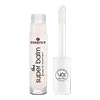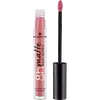What's inside
What's inside
 Key Ingredients
Key Ingredients

 Benefits
Benefits

 Concerns
Concerns

 Ingredients Side-by-side
Ingredients Side-by-side

Polybutene
Diisostearyl Malate
EmollientOctyldodecanol
EmollientSilica
AbrasiveShorea Robusta Resin
TonicGlyceryl Tribehenate/Isostearate/Eicosandioate
EmollientHelianthus Annuus Seed Oil
EmollientButyrospermum Parkii Butter
Skin ConditioningTheobroma Cacao Seed Butter
EmollientTocopheryl Acetate
AntioxidantTocopherol
AntioxidantSodium Hyaluronate
HumectantEthylcellulose
Synthetic Fluorphlogopite
Ethylhexyl Palmitate
EmollientMica
Cosmetic ColorantLupinus Albus Seed Extract
Skin ConditioningTrihydroxystearin
Skin ConditioningGlucomannan
Skin ConditioningAroma
Tin Oxide
AbrasiveCI 77491
Cosmetic ColorantCI 77891
Cosmetic ColorantPolybutene, Diisostearyl Malate, Octyldodecanol, Silica, Shorea Robusta Resin, Glyceryl Tribehenate/Isostearate/Eicosandioate, Helianthus Annuus Seed Oil, Butyrospermum Parkii Butter, Theobroma Cacao Seed Butter, Tocopheryl Acetate, Tocopherol, Sodium Hyaluronate, Ethylcellulose, Synthetic Fluorphlogopite, Ethylhexyl Palmitate, Mica, Lupinus Albus Seed Extract, Trihydroxystearin, Glucomannan, Aroma, Tin Oxide, CI 77491, CI 77891
Isododecane
EmollientTrimethylsiloxysilicate
EmollientOctyldodecanol
EmollientDimethicone
EmollientTribehenin
EmollientPentaerythrityl Tetraisostearate
EmollientSilica
AbrasiveMica
Cosmetic ColorantKaolin
AbrasiveDimethicone/Vinyl Dimethicone Crosspolymer
Skin ConditioningDisteardimonium Hectorite
StabilisingTalc
AbrasiveDiisostearyl Malate
EmollientPolypropylene
Pentaerythrityl Tetra-Di-T-Butyl Hydroxyhydrocinnamate
AntioxidantParfum
MaskingCI 15850
Cosmetic ColorantCI 42090
Cosmetic ColorantCI 45410
Cosmetic ColorantCI 77491
Cosmetic ColorantCI 77492
Cosmetic ColorantCI 77891
Cosmetic ColorantIsododecane, Trimethylsiloxysilicate, Octyldodecanol, Dimethicone, Tribehenin, Pentaerythrityl Tetraisostearate, Silica, Mica, Kaolin, Dimethicone/Vinyl Dimethicone Crosspolymer, Disteardimonium Hectorite, Talc, Diisostearyl Malate, Polypropylene, Pentaerythrityl Tetra-Di-T-Butyl Hydroxyhydrocinnamate, Parfum, CI 15850, CI 42090, CI 45410, CI 77491, CI 77492, CI 77891
Ingredients Explained
These ingredients are found in both products.
Ingredients higher up in an ingredient list are typically present in a larger amount.
Ci 77491 is also hydrated iron III oxide. It's sole purpose is to give a red/pink hue to products.
Iron III oxides are classified as inorganic chemicals for coloring.
Synthetically created Ci 77491 is considered safer than those naturally found. This is because the synthetically created version may contain less impurities. Iron oxides are generally non-toxic and non-allergenic.
Learn more about CI 77491Ci 77891 is a white pigment from Titanium dioxide. It is naturally found in minerals such as rutile and ilmenite.
It's main function is to add a white color to cosmetics. It can also be mixed with other colors to create different shades.
Ci 77891 is commonly found in sunscreens due to its ability to block UV rays.
Learn more about CI 77891Diisostearyl Malate is an emollient and most often used in lip products. It comes from isostearyl alcohol, a fatty acid, and malic acid, an AHA.
As an emollient, Diisostearyl Malate helps create a thin film on your skin to trap moisture in. This helps keep your skin soft and smooth.
Mica is a naturally occurring mineral used to add shimmer and color in cosmetics. It can also help improve the texture of a product or give it an opaque, white/silver color.
Serecite is the name for very fine but ragged grains of mica.
This ingredient is often coated with metal oxides like titanium dioxide. Trace amounts of heavy metals may be found in mica, but these metals are not harmful in our personal products.
Mica has been used since prehistoric times throughout the world. Ancient Egyptian, Indian, Greek, Roman, Aztec, and Chinese civilizations have used mica.
Learn more about MicaOctyldodecanol is a fatty alcohol. It is primarily used to enhance the texture of products.
As an emulsifier, Octyldodecanol helps prevent the oils and waters from separating. It also prevents ingredients from creating foam when shaken.
Octyldodecanol is created by reducing fatty acid to an alcohol.
Due to its high molecular weight, it does not get absorbed into the skin.
Learn more about OctyldodecanolSilica, also known as silicon dioxide, is a naturally occurring mineral. It is used as a fine, spherical, and porous powder in cosmetics.
Though it has exfoliant properties, the function of silica varies depending on the product.
The unique structure of silica enhances the spreadability and adds smoothness, making it a great texture enhancer.
It is also used as an active carrier, emulsifier, and mattifier due to its ability to absorb excess oil.
In some products, tiny microneedles called spicules are made from silica or hydrolyzed sponge. When you rub them in, they lightly polish away dead skin layers and enhance the penetration of active ingredients.
Learn more about Silica